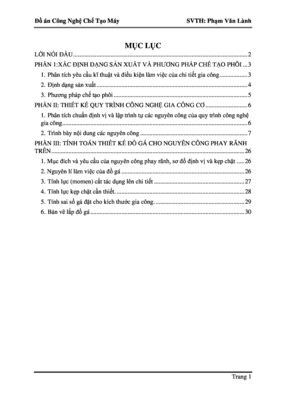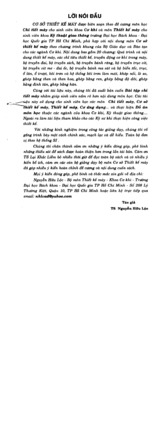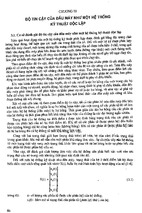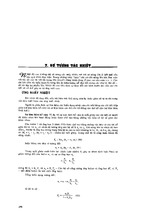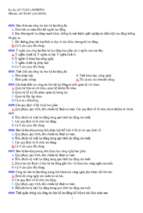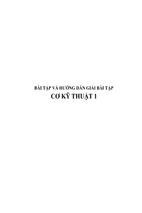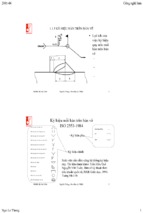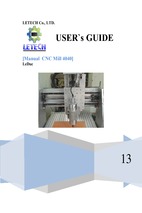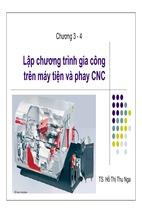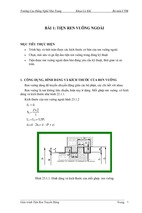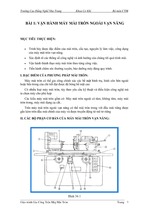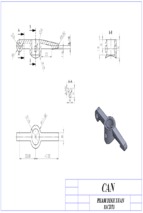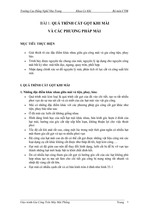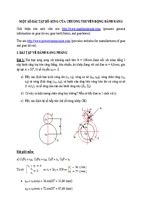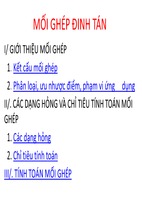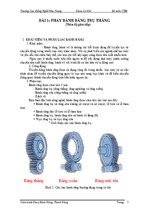Mô tả:
Adhesive Manufacturing Processes
Chapter 10: Protection of labour and
environment
Univ.-Prof. Dr.-Ing. Prof. h.c. Stefan Böhm
Department for Cutting and Joining Manufacturing Processes (tff)
University of Kassel, Germany
Quelle: Wikipedia
Agenda
Introduction
Hazard potential
Sequelae
Occupational Safety
Environmental Protection
2
Reasons for occupational safety during processing of
adhesives
Possibility of contact with potentially dangerous chemical substances
This includes
● Pure materials (elements and compounds)
● Mixtures of substances
Obligation to label exists for all containers, cans, bottles etc. that contain
hazardous materials
3
Safety Data Sheet (SDS)
Instrument for communication of safety-related information about materials
and mixtures
Contains all relevant arrangements required to handle the material or mixture
Manufacturer is obliged to provide a SDS for all products with a obligation to
label
GHS pictograms are used for labeling the materials and mixtures
Quelle: http://www.baua.de
4
Safety Data Sheet (SHS)
Contents of s SHS
1. Declaration of material/mixture and
producing company
9. Physical and chemical properties
2. Possible hazards
10. Stability and reactivity
3. Compounding/Information about individual
contents
11. Information regarding ecology
4. Measurements for fire fighting
12. Toxicologial information
5. First aid measurements
13. Information about disposal
6. Measures for accidental release
14. Information about transport
7. Conditions for handling and storing
15. Instructions
8. Exposition limit and personal protective
equipment
16. Additional information
Quelle: http://www.umweltbundesamt.at/umweltsituation/chemikalien/sdb/
5
Example for a Safety Data Sheet (SHS)
http://www.dr-software.com/deutsch/Sicherheitsdatenblatt_GHS.htm
6
Global Harmonized System (GHS) of Classification and
Labeling of Chemicals
New hazard symbols for chemicals since
1.12.2010 for individual materials, from
1.6.2015 on for mixtures
Common signal words
(e.g. „Danger“, „Warning“)
Hazard statements
Precautionary statements
Quelle: http://www.gcicertified.com
7
Hazard Symbols for Chemicals (1)
New
Symbol
Description
Old
Symbol
Explosives (Danger)
• Material might explode under special conditions (e.g. pressure or temperature)
• Avoid impacts, friction, fire, or sparks
Flamable (Danger)
• Ignites easly within reach of heat or open fire
• Avoid Contact to sources of ignition or hazard
()
Oxidizing (Danger)
• Material can ignite flammable materials or support fire
• Avoid contact to flammable materials
Toxic (Danger)
• Contact to small amounts incorporation can lead to strong or deadly intoxication
• No immediate physical contact
Quelle: vgl. http://www.springer-gup.de
()
8
Hazard Symbols for Chemicals (2)
New
Symbol
Description
Old
Symbol
Corrosive (Danger)
• Even short contact times with skin can lead to scars, contact with eyes can lead to
permanent sight disorders
• Protect skin and eyes
Healt hazard (Danger)
• Materials can cause serious damage to
• Label for carcinogenic materials
• Products are to be used with caution
Irritant (Warning)
• Dangerous for humans
• Materials can cause skin irritations or allergies
• Small amounts do not cause serious health damage or death
Environmental Damaging (Warning)
• Hazardous for animals and environment
• Release can cause short or long term damages
• Do not dispose in waste water or domestic waste
Quelle: vgl. http://www.springer-gup.de
9
Kennzeichnungssystem des GHS
Pictogram
Hazard
Sentences
as
specified
by GHS
Pictogram
Amoung of
material if
public access
is possible
Name, adress,
phone number of
supplier
Danger
P-Sentences
(max. 6)
Signal
word
Quelle: http://www.lagerlogistik-service.de
10
Agenda
Introduction
Hazard potential
Sequelae
Occupational Safety
Environmental Protection
11
Cyanacrylates - Hazards
Irritant
Characteristic: Immediate reaction in the presence of water (also humidity)
Hazards:
● Adhesion of skin
● Adhesion of eye
● Irritation of skin, eye, or respiratory systems
Quelle: http://www.mercateo.com
12
Cyanacrylates – Reactive measures
Inhalation:
● Get person into fresh air, if necessary consult a doctor
Skin contact:
● Soak affected areas in warm water
● Do not try to force adhered areas apart
Eye contact:
● Wash with water
● Do not force adhered eyelids open
Swollowing:
● Do not initiate vomitus
● Supply affected person with a lot of water
Quelle: http://www.mercateo.com
13
Solvent containing substances - Hazards
Flammable
Health hazard
Examples: Solvent containing adhesices, primer, degreaser
Hazards:
● Might affect unborn babies
● Serious health damages when inhaled
● Irritation of skin and eyes
● Vapors might cause tiredness and drownsiness
● Additionally: risk of addiciton
Quelle: deu.sika.com/
14
Solvent containing substances – reactive measures
Eye contact:
● Wash eyes with water
Skin contact:
● Wash affected areas with water
● Remove contaminated clothes and shoes
Swollowing:
● Do not initiate vomitus
● Keep resiratory ducts open
Protection of first aider:
● Hazard when mouth-to-mouth venitlation is required
Quelle: deu.sika.com/
15
PUR - hazards
Irritating
Especially monomeric isocyanates (such as MDI, NDI)
Hazards:
● Irritation of eyes, skin, and respiratory
● Possibly carcinogenic
● Danger of serious health damages from longer inhalation
● Allergisation by inhalation or skin contact
Quelle: http://www.bmua.de
16
PUR – reactive measures
General notice:
● Symptoms of intoxication can occur long time after incident, therefore, medical
supervision is required for at least
Inhalation:
● Fresh air and heat
Skin contact:
● Wash with water and soap
Eye contact:
● Wash several minutes with opened eyelied with water
Swallowing:
● Do not initiate vomitus
Quelle: http://www.bmua.de
17
Epoxide resin - hazards
Consists of component A (resin) and component B (hardener)
Irritating
Corrosive
Hazards:
● Irritation of skin and eyes
● Allergisation by skin contact possible
Resin component
● Damages health when swallowed,
inhaled or by skin contact
● Causes alkali burn
● Allergisation by skin contact possible
Hardener
component
Quelle: Berufsgenossenschaften der
Bauwirtschaft
18
Epoxy resin – reactive measures
Inhalation:
● Fresh air and heat
Skin contact:
● Wash with water and soap
Eye contact:
● Wash several minutes with opened eyelied with water
Swallowing:
● Do not initiate vomitus
Quelle: http://www.bmua.de
19
Processes - Hazards
Surface preparation:
● Degreasing, solvents as primers
– Hazard: Irritations, healt damages when inhaled
● Bating
– Hazard: Serious alkali burn
● Plasmatreatment with ozon
– Hazard: Eye, lung and faucal irritation
● Application, mixing and curing of components:
– Hazard: Release of reaction products, development of heat
Quelle: TC Kleben
20
- Xem thêm -


